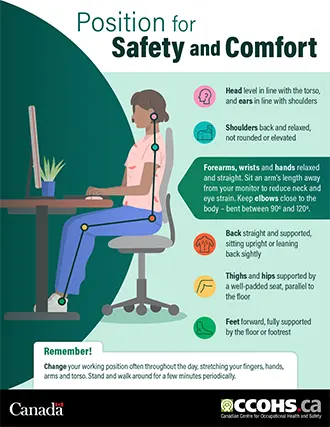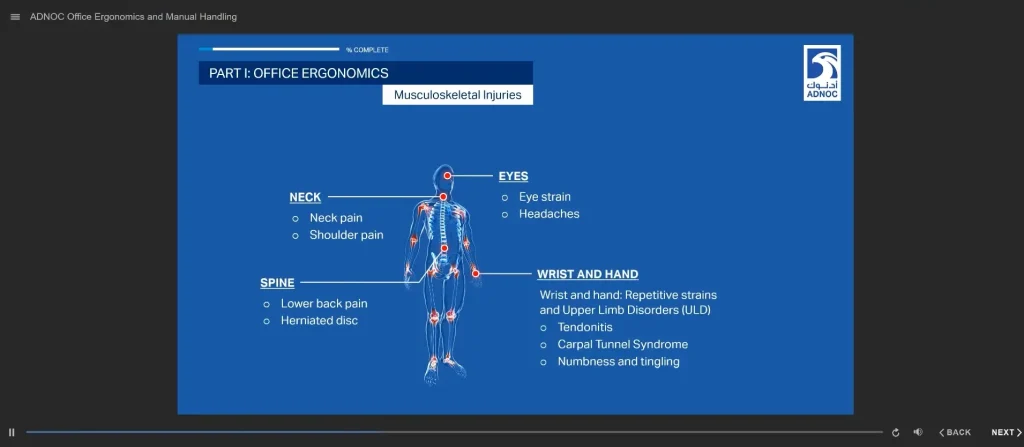Send us a message
We would like to learn more about your challenges and to understand how we can support you.
Get in touch.
Send us a message and we’ll get
back to you within 48 hours.
Alternatively, email
hello@shiifttraining.com
October is recognized as National Ergonomics Month, which serves as a useful reminder of how closely workplace safety and performance are tied to ergonomics. However, the importance of ergonomics extends far beyond a single month. For organizations across industries, ergonomics safety is a year-round priority, and the effectiveness of that safety depends heavily on the quality of ergonomics training provided to employees.
This article explores why ergonomics safety matters, the areas where training is most needed, and the various ways organizations can deliver that training effectively.
In workplace health and safety, ergonomics refers to the science of designing work tasks, equipment, and environments to fit the worker. Rather than expecting employees to adapt their bodies to poorly designed conditions, ergonomics focuses on adapting the work environment to support natural movement and reduce strain.
When applied effectively, ergonomics prevents injuries, enhances comfort, and supports long-term well-being. This makes it a core component of occupational safety, especially in roles involving repetitive tasks, heavy lifting, or extended computer use.
Several factors increase the risk of ergonomic-related injuries. Training programs must help employees recognize and avoid these risks:
Training employees to identify these risk factors is often the first step in preventing injuries before they develop.
Ergonomics safety focuses on fitting the workplace to the worker, reducing strain, and minimizing the risks associated with repetitive or physically demanding tasks. When ergonomics is overlooked, the consequences can include musculoskeletal disorders, repetitive strain injuries, and chronic health problems that develop gradually but impact both individual well-being and organizational performance.
Beyond injury prevention, effective ergonomics safety also improves efficiency. A worker who understands how to adjust their workstation, lift materials correctly, or position their body during patient handling will work with greater comfort and endurance. Reduced fatigue directly translates into higher productivity and fewer mistakes. From a business perspective, minimizing injury risks also reduces absenteeism and long-term healthcare costs, making ergonomics safety an essential part of workplace risk management.
Ergonomic injuries develop gradually over time, often going unnoticed until symptoms become serious. Some of the most common include:
The causes of these injuries almost always connect back to risk factors such as repetition, force, posture, or static positions. This is why ergonomics training must address both the physical environment and the behaviors employees adopt during their tasks.
Office Environments
Office workers are highly susceptible to issues related to poor posture, prolonged sitting, and inadequate workstation setup. Training in this area should cover monitor height and distance, chair adjustment, desk positioning, and the importance of breaks to prevent repetitive strain injuries. Without this training, employees often develop habits that lead to chronic back pain, eye strain, or wrist injuries.
Industrial and Manufacturing Work
For employees in industrial settings, ergonomics training is critical to managing the physical demands of lifting, carrying, pushing, and pulling. Workers who repeatedly perform tasks with awkward postures or excessive force are at a heightened risk of injuries such as hernias, strains, and joint problems. Training should emphasize correct lifting techniques, safe use of tools, and awareness of repetitive motion hazards.
Healthcare and Laboratory Work
Healthcare professionals frequently deal with high-risk ergonomic situations, such as transferring patients, maintaining awkward postures during procedures, and standing for extended periods. Similarly, laboratory staff may spend hours at benches or microscopes, leading to neck, back, and shoulder strain. Ergonomics training in these fields addresses safe patient handling, proper positioning during long tasks, and strategies for alternating movements to reduce fatigue.
Remote and Hybrid Work
With the rise of hybrid and remote work, home office ergonomics has become an area requiring focused training. Many employees lack properly designed office furniture at home, leading to improvised setups that increase the risk of musculoskeletal discomfort. Training for remote workers should include guidance on chair support, screen positioning, and the importance of movement breaks throughout the day.
Effective ergonomics training begins with recognizing risk areas and providing structured education that encourages employees to adjust their work practices. Organizations benefit from conducting ergonomic assessments, which help identify specific risks in various roles. Once those risks are understood, targeted training ensures that employees know how to protect themselves.
Training should not be limited to one-time sessions. Ergonomics safety relies on reinforcement, since habits form over time. Refresher training, feedback mechanisms, and ongoing awareness campaigns help maintain attention to ergonomics and ensure that safe practices become second nature.
Equally important is encouraging employees to communicate early signs of discomfort. Many musculoskeletal injuries develop gradually, and reporting them at an early stage allows adjustments to be made before the problem escalates. Training should therefore also include awareness of early warning signs, such as persistent stiffness or discomfort, and guidance on how to report these issues.
3D Animated Videos
3D safety animation offers a clear and visual method for teaching ergonomics safety. Animations can highlight both correct and incorrect techniques, making it easy for employees to compare outcomes. For instance, a video showing the difference between a properly adjusted workstation and a poorly set-up desk can quickly convey the importance of small adjustments. These videos are effective because they simplify complex ergonomic principles into accessible visual examples.

Screenshot from one of our bespoke 3D animations for ADNOC
Posters and Visual Guides
Although less interactive, posters and quick-reference guides are effective tools for reinforcing ergonomics safety. They serve as visible reminders placed in work areas, ensuring that employees are constantly exposed to safe practices. Posters can illustrate lifting techniques, workstation setups, or stretching routines, making them a low-cost but highly practical method of training reinforcement.

Ergonomics Poster – Credit to Canadian Centre for Occupational Health and Safety (CCOHS)
eLearning Modules
eLearning provides a flexible way for employees to complete ergonomics training at their own pace. Modules can combine text, visuals, and quizzes to reinforce learning. They are particularly useful for large organizations where in-person training may not always be feasible. With eLearning, content can be updated easily to reflect new best practices or regulatory changes, ensuring employees receive consistent and up-to-date training.
See our ‘Office Ergonomics and Manual Handling’ course we created as part of ADNOC’s eLearning course.

Simulation-based Training
Simulations provide an interactive and immersive way for employees to practice ergonomics safety in a controlled environment. In a VR or PC simulation, workers can learn correct lifting techniques, proper posture, or safe movement patterns without real-world risk. They can immerse themselves in a work environment and see an ergonomics hazard from any angle, as if it was happening right in front of them.
For example, a lifting simulation can show how incorrect posture strains the back compared to a safer method, helping employees internalize correct behavior through direct practice.
With virtual reality, it’s even possible to track a user’s body movements and train them in correct positioning and posture, while also detecting whether the user has correct ergonomics to assess them, much like having a real life musculoskeletal expert guide you on ergonomics safety by talking to you in person.
Check out this simulation example of an online simulation training app for James Hardie.
Ergonomics safety is a critical aspect of workplace health, and the effectiveness of that safety depends largely on the quality and consistency of ergonomics training. From offices to industrial facilities, healthcare environments, and home offices, training ensures that workers understand how to adjust their environment and their movements to reduce risk.
Different methods of ergonomics training, from immersive simulations to simple posters, provide organizations with multiple ways to embed safe practices. What remains constant is the need for ongoing attention to ergonomics, ensuring employees are supported in developing habits that reduce strain and prevent long-term injuries.
Deliver next generation training. Get in touch.
Email us at hello@shiifttraining.com or send
us a message and we’ll be in touch within 48hrs.